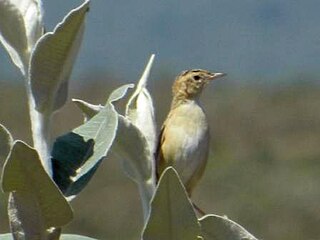
The lesser horseshoe bat is a type of small European and North African insectivorous bat, related to its larger cousin, the greater horseshoe bat. As with all horseshoe bats, the species gets its name from its distinctive horseshoe-shaped noseleaf.

Schlieffen's serotine, also known as Schlieffen's bat or Schlieffen's twilight bat, is a species of vesper bat found in Africa. It has been placed in numerous genera since its first description in 1859, but morphological and genetic studies have confirmed it as the only species in the genus Nycticeinops. It is named for the collector of the original specimen, Wilhelm von Schlieffen-Schlieffiennburg.

The Cape hairy bat, also known as little brown bat, Temminck's mouse-eared bat, Cape myotis, tricoloured mouse-eared bat, Cape hairy myotis, Temminck's hairy bat and three-coloured bat is a species of vesper bat that is found in Sub-Saharan Africa.

Lichtenstein's sandgrouse is a species of bird in the Pteroclidae family, which is named after Martin Lichtenstein. They are nomadic, mostly nocturnal birds, which drink before dawn and after dusk.

The grey-headed batis is a species of bird in the wattle-eyes family, Platysteiridae, it was previously classified with the Old World flycatchers in the family Muscicapidae. It is found in eastern and central Africa.

The black-backed cisticola or black-necked cisticola is a species of passerine bird in the family Cisticolidae. It is found in Burkina Faso, Chad, Republic of the Congo, Democratic Republic of the Congo, Ivory Coast, Eritrea, Ethiopia, Ghana, Guinea, Guinea-Bissau, Kenya, Mali, Nigeria, Senegal, Sierra Leone, South Sudan, Tanzania, Togo, and Uganda. Its natural habitats are subtropical or tropical dry lowland grassland and subtropical or tropical seasonally wet or flooded lowland grassland.

Patrizi's trident leaf-nosed bat is a species of bat in the family Hipposideridae. It is found in Eritrea, Ethiopia, and Saudi Arabia. Its natural habitats are subtropical or tropical dry shrubland and caves.

The Khajuria's leaf-nosed bat, also known as Durga Das's leaf-nosed bat, is a species of bat in the family Hipposideridae. It is endemic to India. Its natural habitat is caves. It is threatened by habitat loss.

The Kolar leaf-nosed bat, or leafletted leaf-nosed bat is a species of bat in the family Hipposideridae. It is endemic to India. Its natural habitats are subtropical or tropical dry forests and caves. It is found in only one cave in India, and its population is less than 200 individuals.

The Pomona roundleaf bat, Pomona leaf-nosed bat, or Andersen's leaf-nosed bat is a species of bat in the family Hipposideridae that is endemic to India.

The Midas free-tailed bat is a species of bat scientifically classified in the order Chiroptera and the family Molossidae. It is distributed from western Africa to Saudi Arabia and further south. Its natural habitats are dry savanna, moist savanna, woodlands and hot deserts. The more southern are also known to live around large rivers or the swamps.

The lesser mouse-tailed bat is a species of microbat in the family Rhinopomatidae. Also referred to as Hardwicke's lesser mouse-tailed bat and long-tailed bat, it is named after Major General Thomas Hardwicke (1755–1835), an English soldier and naturalist who served many years in India. It is found in North Africa, some parts of central and eastern Africa, West Asia and east to the Indian subcontinent.

The greater mouse-tailed bat is a species of bat in the Rhinopomatidae family.

The African giant free-tailed bat, or African free-tailed bat is a species of bat in the family Molossidae. It is found in Democratic Republic of the Congo, Eritrea, Ethiopia, Kenya, Malawi, Mozambique, South Sudan, Tanzania, Zambia, Zimbabwe, and possibly South Africa. Its natural habitats are dry savanna and subtropical or tropical dry shrubland.

Heuglin's wheatear is a small passerine bird in the wheatear genus Oenanthe.

The striped leaf-nosed bat is a species of bat native to eastern and southern Africa. It was formerly considered part of M. commersoni, which is now viewed as being restricted to Madagascar. Both commersoni and it were formerly placed in the genus Hipposideros, but moved to the resurrected Macronycteris in 2017 on the basis of molecular evidence.

Harrison's large-eared giant mastiff bat is a species of bat found in Northeast Africa and the Arabian Peninsula. It was described as a new species in 2015. The IUCN evaluates it as a vulnerable species.

Heuglin's gazelle, also known as the Eritrean gazelle, is a species of gazelle found east of the Nile River in Eritrea, Ethiopia and Sudan. It was considered a subspecies of the red-fronted gazelle or conspecific with Thomson's gazelle and Mongalla gazelle by some authors in the past. This small gazelle stands nearly 67 cm (26 in) at the shoulder and weighs between 15 and 35 kg. The coat is dark reddish brown with a dark reddish stripe on the flanks, except for the underparts and the rump which are white. Horns, present in both sexes, measure 15 to 35 cm in length.

The African trident bat is a species of bat found in Africa.
The Egyptian mouse-tailed bat is a species of mouse-tailed bat found in North Africa and the Middle East.




















